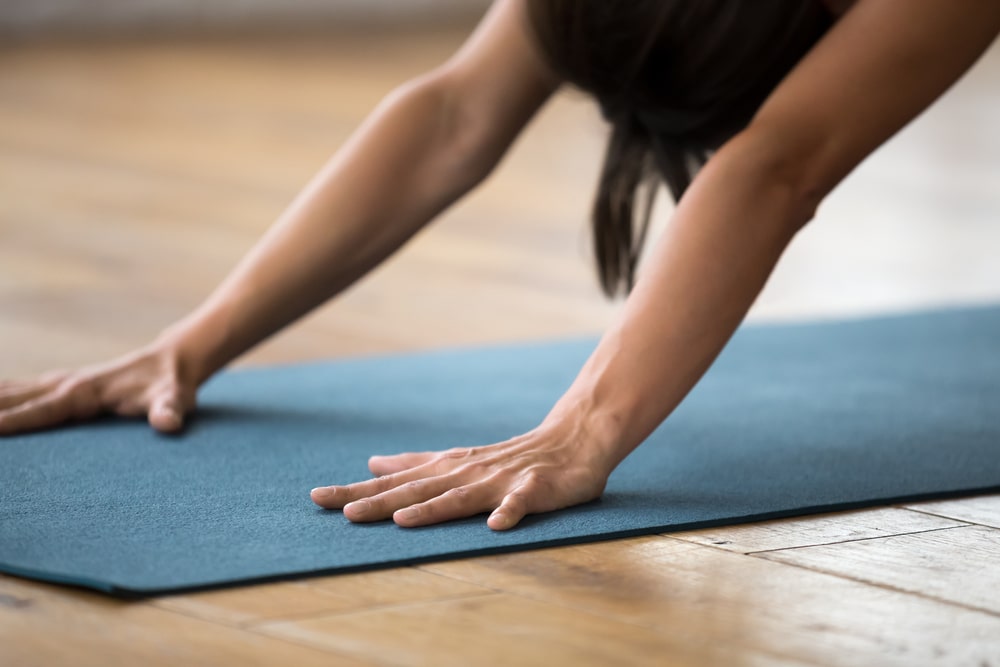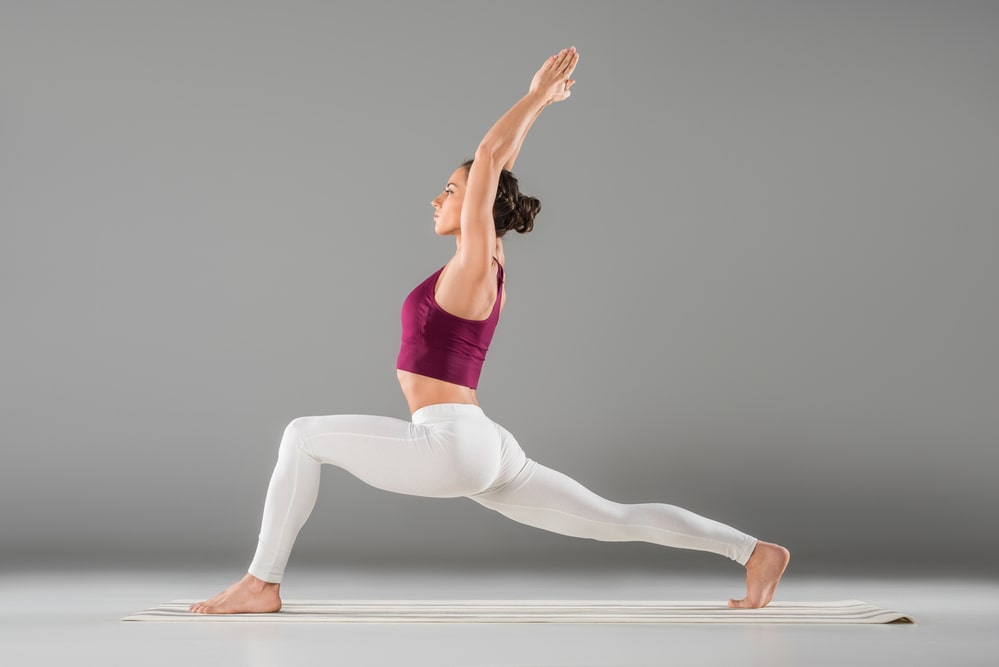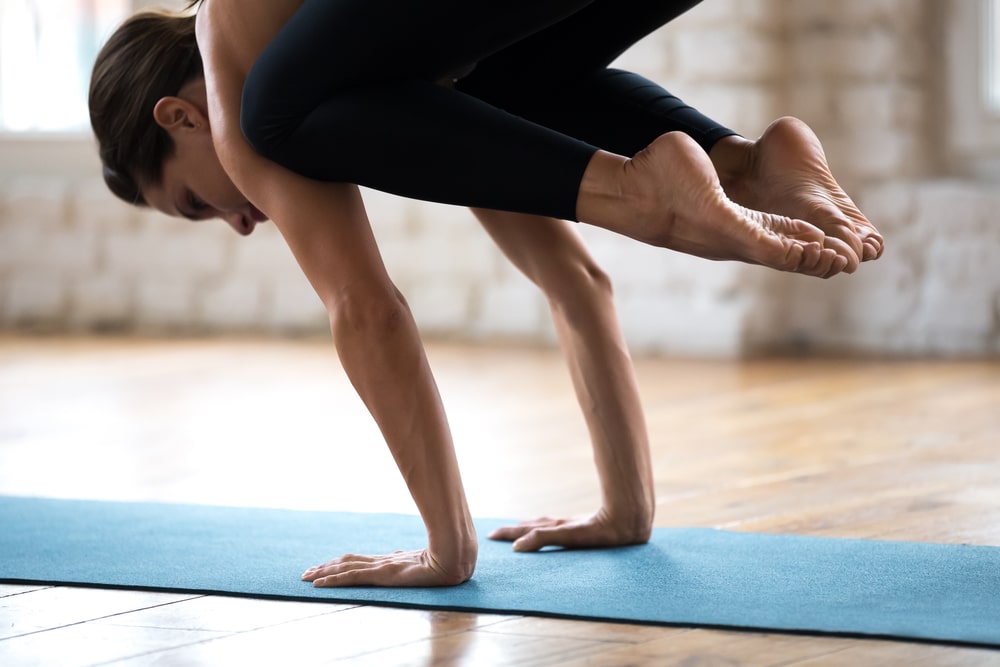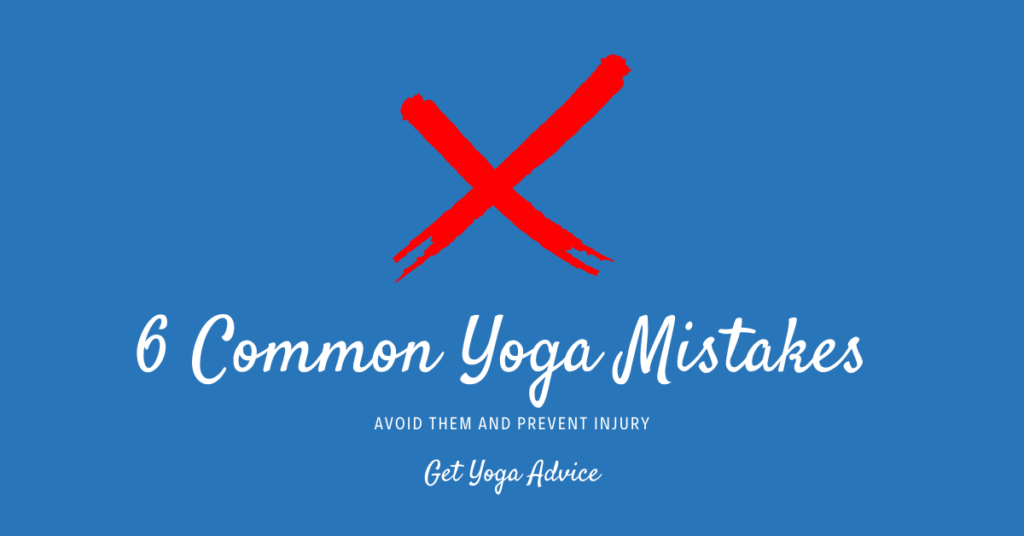When practiced correctly, yoga can improve flexibility, tone muscle, reduce stress levels, and even alleviate anxiety and depression. However, in yoga as in other types of physical activity, bad form can leave you vulnerable to muscle strain and over-stretching of the joints.
This is especially common for those of us yogis who practice at home without an instructor to keep us honest. Looking out for the following common yoga mistakes can help you avoid injuries that might get in the way of your practice.
- 1. You’re Not Engaging Your Hands
- 2. You’re Not Engaging Your Core
- 3. You’re Setting Up Your Standing Poses Incorrectly
- 4. You’re Trying Difficult Poses Too Soon
- 5. You’re Ignoring Physical Pain
- 6. You’re Starting Out With Still Photos Rather Than a Live Yoga Instructor or Video
- Final Word on Common Yoga Mistakes
Contents
- 1 1. You’re Not Engaging Your Hands
- 2 2. You’re Not Engaging Your Core
- 3 3. You’re Setting Up Your Standing Poses Incorrectly
- 4 4. You’re Trying Difficult Poses Too Soon
- 5 5. You’re Ignoring Physical Pain
- 6 6. You’re Starting Out With Still Photos Rather Than a Live Yoga Instructor or Video
- 7 Final Word on Common Yoga Mistakes
1. You’re Not Engaging Your Hands

In many styles of yoga, we place a significant amount of weight on our hands. Unfortunately, our wrists take the brunt of this strain. To avoid this, remember to engage all parts of your hands from the palms to the fingertips.
This simple gesture helps to distribute the weight of your body more evenly, and it will prevent strain while strengthening the muscles in your hands and wrists.
In the middle of a pose, you can do this by lifting all your fingers and then pressing them back down into the mat. This rule applies to wrist-straining poses such as:
- Downward/Upward Facing Dog
- Plank poses
- Crow Pose
- Handstands
2. You’re Not Engaging Your Core
When we are tapped into the flow of our practice, it can be tempting to let our bodies hang loosely from the strength in our arms, legs, and shoulders. However, it’s important to engage your core throughout your practice in order to protect the lower back and spine.
Be sure to check in with your lower abdominal and pelvic floor muscles, tightening them during your yoga flow.
This is especially important while:
- Rising from a Forward Fold
- Holding a Plank pose or chaturanga.
- Lifting your hips into Bridge Pose
To strengthen your core, try incorporating postures like Chair Pose (Utkatasana), Forearm Plank, and Boat Pose (Paripurna Navasana) into your practice.
3. You’re Setting Up Your Standing Poses Incorrectly

Standing poses such as Warrior I, High Lunge, and Triangle Pose rely on a strong foundation in the lower body. When our bodies are not properly aligned in these poses, the resulting knee strain can cause pain or injury. It’s quite common to leave the knees vulnerable by:
- Locking the knees rather than engaging the muscles around them
- Overextending the knees
- Extending the knee past the toes in lunge postures
In standing poses where you step forward with a bent knee such as Warrior I, remember to step toward the thumb of the same hand. Keep your knee pulled back so that it is directly over your ankle rather than poking out over your toes.
Think about rotating your knee just slightly towards the pinky-toe side of that same foot.
On your back leg, remember to position your knee at the same angle as your toes. Peel your back hip outwards to give your back knee more freedom to move.
In poses with a straight front leg (like a Triangle Pose or Tree Pose), create a small bend in your front knee to prevent hyperextension, and keep the muscles around the knee engaged.
4. You’re Trying Difficult Poses Too Soon
At the onset of our yoga journey, we are often amazed and fascinated by online images of experienced yogis performing perfect balancing poses and backbends. We might be inspired to get back on our mats and try out exactly what they’re doing.
While it’s always important to keep this natural curiosity intact during your practice, remember that it’s okay if you can’t perform a difficult pose right away! You should never try to force your body into a posture that it’s not ready for.
Here are a few poses that beginners should take caution in trying, as they can easily cause joint or spine injury:
- Handstands (like vertical handstands or Firefly Pose)
- Backbends (like King Pigeon Pose)
- Full Lotus Pose
- Single-leg Dancer’s Pose
5. You’re Ignoring Physical Pain

Your body will tell you when you are pushing it too far. During your yoga practice, listen to your body and stop if any physical pain occurs. This can happen quite frequently if you are just beginning your yoga journey, if you have any preexisting joint pain, or if you’ve had a muscle injury in the past.
While pain during yoga can be disheartening, it’s important to remember that your modifications are always there for you. Modifying a pose is not a sign of weakness; rather, it’s a sign that you’re tuning in to your body, a vital element of yoga practice.
Here are a few ways to modify basic yoga poses to prevent knee, back, or hip pain:
- Use a yoga block to prop up the pelvis in folding poses like Child’s Pose and Pigeon
- Use rolled towels to lift the knees in seated poses
- Substitute Baby Cobra for chaturanga in a vinyasa flow
- Perform plank poses with your knees on the ground
If you are practicing with an in-person teacher, don’t be shy! Ask them for help in customizing the yoga routine to meet your needs. Oftentimes, their modifications will make you feel better and encourage you to keep practicing, which is what matters in the long run.
Always keep in mind that discomfort is not a bad thing, but pain is never a good thing in your yoga practice.
6. You’re Starting Out With Still Photos Rather Than a Live Yoga Instructor or Video
In today’s world, it’s all too easy to look up yoga routines online, and articles with photos can certainly be helpful resources. But when you actually step onto your mat, nothing compares to a real human voice guiding you throughout your practice.
This is the best way to hear suggestions for improving your posture and alignment in real time as you practice, which will prevent injury.
Luckily, more and more yoga instructors are providing content online for free in the forms of smartphone apps, voiced animations, YouTube videos, and even podcasts. A few great resources to follow along with are:
- Yoga with Adriene on Youtube
- Down Dog Yoga App
- Nike Training Camp App
- Fightmaster Yoga on Youtube
- DoYogaWithMe.com
Final Word on Common Yoga Mistakes
Although it can be a low-impact form of exercise, yoga can cause muscle strain and overextension like other kinds of physical activity. No need to fear; once you work these 6 simple corrections into your routine, you’ll be on your way to enjoying all of the amazing benefits that yoga has to offer.



